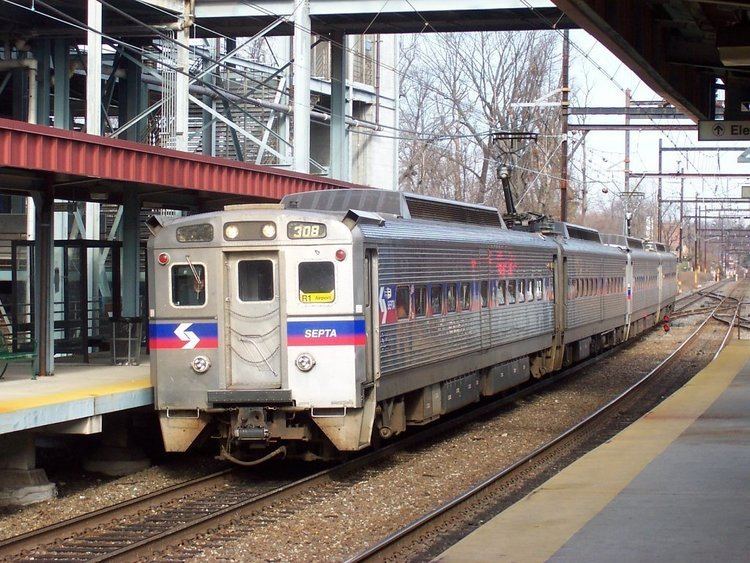In service 1974–present Built at Erie, Pennsylvania Number built 232 | Manufacturer General Electric, Avco Family name Silverliner | |
 | ||
Formation Single unit/ Married pair | ||
The 232 car order of Silverliner IV cars, delivered between 1973 and 1976, represented the largest order of the Silverliner series to date and allowed for the retirement of most of the Reading 'Blueliner' and PRR MP54 MU cars, dating from at least the 1930s, that were still running on their respective Reading and Pennsylvania Railroad systems. Three times the size of the previous Silverliner orders put together, the Silverliner IVs became SEPTA's standard passenger rail vehicle from 1976 on. Like the Silverliner IIs and IIIs before them, the IVs were owned by SEPTA and provided to the private railroads for use in their state supported commuter rail operations until SEPTA took over direct operation in 1983.
Contents
Features
The cars were ordered from General Electric and Avco. Aside from the boxier look and smaller side windows, the main changes between the new IVs and earlier Silverliners included a dynamic brake system, for which the resistance grids were fitted in the car's signature roof hump, and, for the Penn Central cars, a trainline automatic door system which removed the need for train crew to manually open doors at high level platforms. The Silverliner IVs were also the first to be delivered in a married pair configuration, although a minority of cars were outfitted as single units. The delivery of the Silverliner IVs allowed SEPTA to replace most of its remaining PRR MP54s and Reading's pre-war MU fleet save for the 38 rebuilt "Blueliner" cars. While being fitted with an updated propulsion system from General Electric, the Silverliner IVs were nevertheless still delivered with Ignitron tube rectifiers, which were later replaced with silicon controlled rectifiers.
A readily apparent external feature of the Silverliner IV is a windowed body panel plug in the middle of the cars on each side, a provision for high-platform-only center doors which have never been installed, in contrast with New Jersey Transit's similar, contemporary Arrow II and III cars which were built with such doors. Internally, pairs of seats occupy this partitioned area which was intended for passenger flow.
Delivery
The Reading got the first batch of Silverliner IVs in the form of 14 single unit cars produced during 1973. The first two (#9018 and #9019) were unveiled to the press on Thursday, February 21, 1974. These were numbered in series with their existing Silverliner IIs, 9018 through 9031. In 1974-75 the Penn Central took delivery of 34 single units numbered 270 through 303. Delivery of the Silverliner IVs were briefly interrupted by the production of 70 Arrow II cars for the New Jersey Department of Transportation before the Penn Central received 96 pairs numbered 304 through 399. Finally in 1976 the Reading took delivery of a final batch of 88 pairs numbered 101 through 188. All the IVs were delivered with the circular SEPTA logo on the left, and the Penn Central or Reading logo on the right, of all car sides and ends, although the Reading black diamond logo was omitted (and the space left blank) on cars 129-188 which were delivered after the Reading Company was absorbed into Conrail on April 1, 1976. These logos remained mostly intact until 1983, when SEPTA took over commuter rail operations from Conrail and quickly began applying its current rectangular logo over all the others.
Modifications
The Silverliner IVs have never been officially rebuilt, but there have been a number of modifications to the class. The propulsion system was initially upgraded from the original mercury arc–based Ignitron rectifiers to more reliable solid state silicon controlled rectifiers and later the main transformers had their coolant replaced with one that did not contain PCBs. As this change was carried out in the early 1990s, all of the 9000 series Reading cars and some of the Penn Central cars were renumbered into the series 400 through 460 to help keep track of which units had undergone the modification. When the Center City Commuter Connection opened in 1984, the Reading cars were converted to full train automatic door operation to take advantage of the high level platforms at the new Market East Station (now Jefferson Station) and others on the former PRR "side" of the system. In the late 1990s the fleet received its most noticeable upgrade with the original "ketchup and mustard" colored interior replaced with a softer gray motif as well as softer seating. Around 2004 SEPTA began to replace the cowcatcher pilots equipped on the original Reading cars with a bar type pilot to match those on the PRR cars. Starting in 2009 SEPTA began to replace the original Faiveley pantographs with more modern Schunk type units.
Service history
The Silverliner IV fleet has provided service on all of SEPTA's Regional Rail routes, providing the backbone of SEPTA's service plan with older equipment tending to be used on peak services only. Most SEPTA trains consist of a single pair of Silverliner IVs, with longer trains made up as needed. The single units are most frequently coupled to pairs to make 5 or 3 car trainsets, although single units are run alone on Cynwyd Line service. Only one car, #9020, has been retired as of 2016 after a severe rear end collision in the vicinity of the North Wales station in 1980, which damaged the car beyond repair. In 2013, SEPTA announced it had begun the process of replacing the Silverliner IV fleet, and in 2015, listed the replacement of the Silverliner IV with the as of yet built Silverliner VI as part of its ongoing renewal program, though no timeline was given for the retirement of the Silverliner IV fleet.
